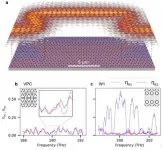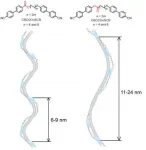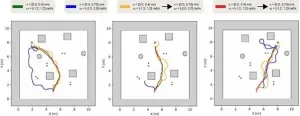(Press-News.org) RICHLAND, Wash.--E-cigarettes stress and inflame the lungs of rats, compromising important regulatory proteins through exposure, according to research recently published in the journal Redox Biology. The findings, made possible by a biomolecular technique developed by researchers at the U.S. Department of Energy's Pacific Northwest National Laboratory, reveal that vaping induces subtle structural changes in proteins, marking the first time researchers have measured such damage. The results suggest that common compounds in the electronic alternative to conventional cigarettes are not without their own harms.
After exposing rats to e-cigarette vapor for three one-hour sessions for three days, researchers discovered signs of oxidative stress: an imbalance between the production of free radicals and the body's ability to mitigate their harmful effects. Free radicals are molecules with unpaired electrons, an inevitable byproduct of the body's many biochemical processes and, when in disproportionately large supply, a contributor to disease and dysfunction.
Previous research has shown that vaping can stress tissues, but the mechanisms and details behind that stress have remained murky. The new technique, said biochemist Charles Ansong, a coauthor of the study who led the research while at PNNL, identifies modifications made to proteins that shed light on how e-cigarettes lead to dysfunction.
"There have been a number of studies on this, and they generally have gross measures that say, 'OK, there's some oxidative stress going on here, but we don't really know what's going on,'" said Ansong, who has since become a program director in the Biochemistry and Bio-related Chemistry Branch of the National Institute of General Medical Sciences/National Institutes of Health. "But this technique identifies which proteins are being modified, which sites are modified, and it suggests how likely they are to impact protein function and molecular pathways. It gives us a lot of insight into the mechanism behind the injurious effects of e-cigarettes."
Bioanalytical chemist and coauthor Wei-Jun Qian, who developed and applied the technique to characterize protein changes at PNNL, said the results indicate that e-cigarettes certainly compromise cellular function, though exactly how bad the damage is remains an area of future investigation.
At the University of Rochester Medical Center in Rochester, N.Y., where the animal portion of this research was performed, rats inhaled a mixture of three compounds common in most e-cigarette liquids: propylene glycol (a synthetic liquid often found in cosmetics), vegetable glycerin and nicotine.
"I don't think many people think about how thick or viscous these liquids are," said Matthew McGraw, a physician scientist in pediatric pulmonary medicine at the University of Rochester Medical Center and coauthor of the study. "Vegetable glycerin is used in cooking oil. To heat that cooking oil and inhale it into your lungs--when you think about it, even just visually, that's quite a thing to do."
Looking at the lung tissue beneath the microscope revealed few changes after exposure. The researchers saw no significant shift in the number of white blood cells in lung fluid, nor did they observe any glaring differences in lung structure.
But Qian's protein analysis revealed thousands of oxidative changes, pinpointing subtle, reversible modifications that had previously evaded detection. Exposure altered a range of protein types, mainly those that regulate quality control in other proteins.
"Whatever biomolecular pathway that protein is a part of may be impaired, and that can lead to tissue dysfunction and disease" said Ansong, who compared abnormal proteins to biomolecular trash that can snowball into larger problems when regulatory pathways are compromised, leaving the body unable to keep its systems clean.
E-cigarette exposure modified multiple proteins associated with the body's inflammatory response, suggesting that frequent e-cigarette use could push the lungs into a state of chronic stress. Some of the detected changes promote clotting and systemic inflammation and were akin to those found in the lungs of traditional smokers, said McGraw, potentially implicating e-cigarettes as drivers of an inflammatory state. The greatest change in these pathways occurred when rats inhaled propylene glycol and vegetable glycerin alone; the addition of nicotine did not significantly change the lung's stress response.
These protein alterations mark just one type of observed change, said Qian, leaving other potential alterations that could remain undetected.
"Oxidation is just one type of modification," said Qian. "It's not the only type. And we're only just beginning to understand this. I believe many other types of protein function can be monitored, too."
The group also plans to systematically explore other e-cigarette additives, like popular flavoring compounds, as well as varying doses and exposure levels. While the results stand as evidence of oxidative stress, the exact effect on human users is uncertain.
"Others have said that vegetable glycerin and propylene glycol are relatively safe," said McGraw. "While our results do not fully discredit that comment, we can say repeated inhalation exposure to e-cigarettes causes significant oxidative stress within the lung. This stress is an early sign that there could be potentially harmful, long-term changes if posed repetitively."
The findings arrived after the city of San Francisco enacted a ban on e-cigarettes in 2019, with the law taking effect in 2020. The District of Columbia, Puerto Rico and 15 states passed laws in 2020 that restrict indoor smoking, including vapor produced by e-cigarettes, according to the Centers for Disease Control and Prevention.
INFORMATION:
This article discusses research conducted in part by Charles Ansong while he was employed as a researcher at Pacific Northwest National Laboratory from 2006-2020. The opinions expressed do not reflect the view of the National Institutes of Health, the Department of Health and Human Services, or the United States government.
Pacific Northwest National Laboratory draws on signature capabilities in chemistry, Earth sciences, and data analytics to advance scientific discovery and create solutions to the nation's toughest challenges in energy resiliency and national security. Founded in 1965, PNNL is operated by Battelle for the U.S. Department of Energy's Office of Science. DOE's Office of Science is the single largest supporter of basic research in the physical sciences in the United States and is working to address some of the most pressing challenges of our time. For more information, visit PNNL's News Center. Follow us on Facebook, Instagram, LinkedIn and Twitter.
Some say future wars will be fought over water, and a billion people around the world are already struggling to find enough water to live.
Now, researchers at the National University of Singapore (NUS) are coming to the rescue. They have created a substance that extracts water from air without any external power source.
In the earth's atmosphere, there is water that can fill almost half a trillion Olympic swimming pools. But it has long been overlooked as a source for potable water.
To extract water from this under utilised source, a team led by Professor Ho Ghim Wei from the NUS Department of Electrical and Computer Engineering created a type of aerogel, a solid material that weighs almost nothing. Under the microscope, it looks like a sponge, but it ...
University of South Australia scientists have developed the world's first test to accurately predict mood disorders in people, based on the levels of a specific protein found in the brain.
Links between low levels of mature brain-derived neurotrophic factor (mBDNF) and depression are well known but, until now, it hasn't been possible to distinguish between the three forms of the BDNF protein in blood samples.
The mature form promotes the growth of neurons and protects the brain, but the other two BDNF forms - its precursor and the prodomain of BDNF - bind to different receptors, causing nerve degeneration ...
SINGAPORE, 19 January 2021 - Duke-NUS Medical School researchers, together with collaborators in Singapore, have designed armoured immune cells that can attack recurring cancer in liver transplant patients, while temporarily evading immunosuppressant drugs patients take to avoid organ rejection. The findings were published in the journal Hepatology.
Hepatocellular carcinoma is the most common type of primary liver cancer and the sixth most common cancer worldwide. It often develops in people with chronic liver disease following hepatitis B infection.
A common treatment for hepatocellular carcinoma is to completely ...
Topologically tailored photonic crystals (PhC) have opened up the possibility for attaining robust unidirectional transport of classical and quantum systems. The demand for unprecedented guiding capabilities that support unhindered transport around imperfections and sharp corners at telecom wavelengths, without the need for any optimization, is fundamental for efficient distribution of information through dense on-chip photonic networks. However, transport properties of experimental realizations of such topologically non-trivial states have been inferred by transmission measurements and even though robustness ...
Overview:
A team of researchers led by Assistant Professor Yuki Arakawa (Toyohashi University of Technology, Japan) has successfully developed sulfur-containing liquid crystal (LC) dimer molecules1) with oppositely directed ester bonds, which exhibit a helical liquid crystal phase, viz. twist-bend nematic (NTB) phase, 2) over a wide temperature range, including room temperature. Collaboration with a team at the Advanced Light Source research facility (Lawrence Berkeley National Laboratory, USA) revealed that the ester bond direction in the molecular structures largely impacts the pitch lengths of helical nanostructures in the NTB phase. It is expected that this molecular design ...
Overview:
A research group from the Active Intelligent System Laboratory (AISL) at Toyohashi University of Technology (TUT) has proposed a new framework for training mobile robots to quickly navigate while maintaining low collision rates. The framework combines deep reinforcement learning (DRL) and curriculum learning in the training process for robots to learn a fast but safe navigation policy.
Details:
One of the basic requirements of autonomous mobile robots is their navigation capability. The robot must be able to navigate from its current position to the specified target position ...
CHAMPAIGN, Ill. -- The fossilized insect is tiny and its genital capsule, called a pygophore, is roughly the length of a grain of rice. It is remarkable, scientists say, because the bug's physical characteristics - from the bold banding pattern on its legs to the internal features of its genitalia - are clearly visible and well-preserved. Recovered from the Green River Formation in present-day Colorado, the fossil represents a new genus and species of predatory insects known as assassin bugs.
The find is reported in the journal Papers in Palaeontology.
Discovered in 2006 by breaking open ...
Simple vision tests can predict which people with Parkinson's disease will develop cognitive impairment and possible dementia 18 months later, according to a new study by UCL researchers.
The study, published in Movement Disorders, adds to evidence that vision changes precede the cognitive decline that occurs in many, but not all, people with Parkinson's.
In another new study published today in Communications Biology, the same research team found that structural and functional connections of brain regions become decoupled throughout the entire brain in people with Parkinson's disease, particularly among people with vision problems.
The ...
There are high hopes for the next generation of high energy-density lithium metal batteries, but before they can be used in our vehicles, there are crucial problems to solve. An international research team led by Chalmers University of Technology, Sweden, has now developed concrete guidelines for how the batteries should be charged and operated, maximising efficiency while minimising the risk of short circuits.
Lithium metal batteries are one of several promising concepts that could eventually replace the lithium-ion batteries which are currently widely used - particularly in various types of electric vehicles.
The big advantage of this new battery type is that the energy density can be significantly ...
New research suggests a unique program called Moms2B at The Ohio State University Wexner Medical Center shows a reduction in adverse pregnancy outcomes in communities disproportionately affected by these public health issues.
The study, led by researchers Courtney Lynch and Erinn Hade and published in the Journal of Maternal and Child Health, indicates that women who attended at least two Moms2B sessions may have lower rates of preterm birth, low birth weight and infant mortality compared to women who only received individual care.
"When we started the program 10 years ago, ...






